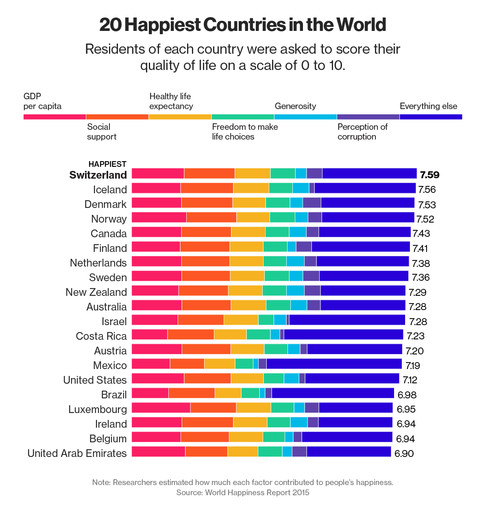The U.S. ranks No. 15 among 158 countries in the World Happiness Report 2015
Happiness seems to be most abundant a long way from the equator. At least according to the new World Happiness Report 2015. The 10 happiest countries are Switzerland, Iceland, Denmark, Norway, Canada, Finland, Netherlands, Sweden, New Zealand, and Australia. Except for war-torn Syria and Afghanistan, the 10 unhappiest countries are all in Saharan or sub-Saharan Africa.
Then again, you don’t have to be shivering to be happy. Israel and Costa Rica are the 11th and 12th happiest countries. As for those at the bottom, their unhappiness probably has a lot more to do with poverty and violence than with proximity to the zero latitude line.
The U.S. is the 15th happiest country of the 158 covered by the survey, which obtained its data primarily from the Gallup World Poll. That puts the U.S. just behind Mexico (14) but ahead of Brazil (16), Britain (21), Japan (46), Russia (64), China (84), and Iran (110).

The World Happiness Report grew out of a project from Bhutan, a Buddhist kingdom of 700,000 people in the eastern Himalayas whose prime minister, Jigmi Y. Thinley, set out to measure Gross National Happiness. Thinley got the United Nations to adopt a 2011 resolution inviting member nations to measure their happiness as a guide to improving public policies. This is the third World Happiness Report. The first was in 2012 and the second in 2013 (it wasn’t designed to be an annual undertaking, hence no report last year).
Women tend to be happier than men in North America, Australia-New Zealand, and South and East Asia, among other regions, but less happy than men in Eastern Europe, the former Soviet Union region, and sub-Saharan Africa, the report found. For both men and women, happiness drops from the teenage years until 40 or 50 and then stabilizes.
Nicaragua and Zimbabwe saw the biggest increases in happiness from 2012 to 2014. Greece suffered the biggest decrease, followed by Egypt, Italy, and Saudi Arabia.
Close all those tabs. Open this email.
Gallup’s questionnaire is based on the Cantril Scale, in which people are asked to place themselves on a scale of 10 down to zero, and “the top of the ladder represents the best possible life for you and the bottom of the ladder represents the worst possible life for you.” As such, the survey measures people’s sense of well-being rather than their mood at the time of the survey. The report averages responses for 2012 through 2014.

The report was published by the Sustainable Development Solutions Network, which was launched by UN Secretary General Ban Ki-moon in 2012. A disclaimer states that the report was written by independent experts and doesn’t necessarily reflect the views of the UN. In a press conference announcing the results, co-author Jeffrey Sachs, director of the SDSN and of the Earth Institute of Columbia University, said he hopes UN members will use the report in establishing Sustainable Development Goals for the next 15 years, which are supposed to be set later this year.
Social cohesiveness is hugely important to a society’s happiness, the report says. Iceland’s high level of trust helped it stay happy despite a serious financial crisis, while Spain, Italy, and Greece tumbled in the happiness rankings in part because they lacked the cohesiveness to pull through their financial troubles, say the authors.
It may not be a complete coincidence that cold countries are happier, co-author John Helliwell–a Canadian–said at the press conference. “In a harsh climate, it’s precisely where you have to develop these capacities to collaborate or you won’t survive,” said Helliwell, a fellow of the Canadian Institute for Advanced Research. Later he called that an “off-handed observation.” Sachs said, “I would caution first of all any geographic determinism,” while adding, “I would take it as an interesting observation for reflection.”





Comments